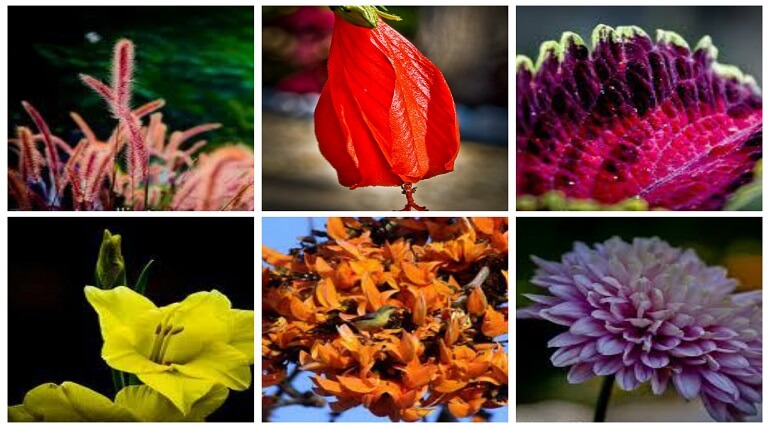
Flora and Fauna: The different habitat types of Corbett i.e. mountains, sal forests, chaurs, khair-sissoo forests, and rivers have their distinct assemblage of plants. More than 600 species of trees, shrubs, herbs, bamboos, grasses, climbers and ferns have been identified in the Park.
Trees
The most visible trees found in Corbett are sal, sissoo and khair. Many other species that contribute to the diversity are found scattered throughout the park. Chir pine is the only conifer of the Park and is found on ridge-tops like Chir Choti but comes quite low in Gajar Sot. The upper reaches near Kanda have Banj Oak growing, which is essentially a Himalayan species.
Palms include Date palm that grows in open areas. Kanju (Holoptelia integrifolia), Jamun (Syzygium cumini) and Aamla (Emblica officinalis) are found scattered moist areas. Other major tree species are
- Bel
- Kusum
- Mahua
- Bakli
Flowering trees lend colour to the forests in Corbett. The main ones are Kachnaar (Bauhinia variegata) with pink to white flowers, Semal (Bombax ceiba) with big red blooms, Dhak or Flame-of-the-forest (Butea monosperma) with bright orange flowers, Madaar or Indian Coral (Erythrinia indica) with scarlet red flowers and Amaltas (Cassia fistula) with bright yellow chandelier like blooms.
Some species of trees that do not occur naturally in the Park have been artificially planted in and around habitation. These include:
- Teak (Tectona grandis)
- Eucalyptus
- Jacaranda
- Silver Oak
- Bottlebrush
Grasses
Grasses form the largest group of plant species in Corbett with more than 70 species recorded. They occupy different habitats, especially chaurs. They include:
- Kansi
- Themeda arundinacea
- Baib or Bhabar
- Narkul
- Tiger Grass
- Khus Khus
Spear Grass with conspicuous sharp blades that adhere to clothes and penetrates skin.
Bamboo
In some parts of Corbett the vegetation is dominated by bamboo forest. The main species is Male Bamboo having clustered stout stems and shining papery stem sheaths. Bamboos follow a peculiar flowering process. All bamboos in a forest flower together at the same time once in several decades. After flowering, fruiting and dispersal of seeds, all plants die together.
Shrubs
Shrubs dominate the forest floor. There are several species of Ber found in open areas that provide food and habitat to many birds and animals. Maror phali is an easily noticeable shrub. Its fruits are in the form of twisted spiraling pods. Karaunda with pinkish-white flowers and sour fruit is found under sal. Hisar has yellow, juicy, berry-like fruits that are savoured by animals. Jhau is found along the Ramganga basin on sandy or rocky soil.
Fauna
The fauna found in Jim Corbett National Park is rich and varied. There are over 600 species of birds along with 50 mammal species and 25 reptile species; hence, over the years, this park has become one of the best wildlife spots sports in India.
Mammals
The Bengal tigers are found in a fairly good population of the Park; hence, it is one of the critical tiger protection regions under Project Tiger.
Bengal Tiger (Panthera tigris tigris): This is the most prominent of the species found in the park. Jim Corbett, with its large population, offers some of the finest opportunity in the country to view these magnificent predators in their natural habitat.
Asian Elephant (Elephas maximus): These ΑGeneratedValue are commonly encountered in the park in small to large herds and play a vital role in the maintenance of the park's ecological balance.
Leopard (Panthera pardus): Leopards have innovative habitats than tigers and are also found here, although they are very shy and stealthy in their presence.
Deer species: In the park, various deer species like Chital (Axis axis), Sambar (Rusa unicolor), and Barking Deer (Muntiacus muntjak) among the herbivores form the typical prey base for the carnivores.
The wild boar (Sus scrofa) is quite frequent in the park and is very useful for the ecosystem by aerating the soil.
Birds
Meeting more than 600 plus recorded bird species, Jim Corbett National Park is literally a paradise for bird watchers. The park has both residents and migratory birds.
Crested Serpent Eagle: A very common raptor in this park.
Indian Pitta: By its bright-colored plumage, it can easily be seen in the forest areas in this park.
Great Hornbill: This large bird, together with its slow and measured wingbeats and the distinctive casque atop the bill, draws many a bird watcher's attention.
Waterfowl: Common Kingfisher, Stork-billed Kingfisher, and the White-throated Kingfisher are seen beside water bodies.
Migratory Birds: Winter months attract a few migratory birds like the Siberian Crane and species of ducks and geese.
Reptiles
The reptilian fauna is equally impressive in the park, represented by a number of species of lizards, snakes, and turtles.
Indian Python (Python molurus): This is a large snake often found near waterbodies within the park.
Ophiophagus hannah: The King Cobra, one of the most toxic alliurid snakes in the whole world, occupies the thick forests of the park.
Monitor Lizard: These large lizards are almost a common feature, sometimes basking in the sun while at other times seeking their prey.
Amphibians and Fish
The aquatic habitats of the park support a variety of amphibians and fish. Frogs, toads, and salamanders are common, and the park’s rivers and streams are home to species like Mahseer and Goonch, which are prized by anglers.
FAQs
1. What types of habitats are present in Jim?Corbett?National?Park?
The park contains a variety of habitats including mountains, sal forests, khair?sissoo forests, bamboo belts, riverine systems and “chaurs” (grasslands). Solluna Resort
2. How many plant species have been recorded in the park?
More than 600 species of trees, shrubs, herbs, bamboos, grasses, climbers and ferns have been identified in the park. Solluna Resort
3. What are the dominant tree species found in the park?
Some of the prominent trees are:
-
Sal, sissoo and khair forests. Solluna Resort
-
Chir pine (on ridge-tops). Solluna Resort
-
In upper regions, Banj Oak (a Himalayan species) near Kanda. Solluna Resort
-
Date palm, Kanju (Holoptelia integrifolia), Jamun (Syzygium cumini), Aamla (Emblica officinalis). Solluna Resort
4. What flowering trees add colour to the forest?
Examples include:
-
Kachnaar (Bauhinia variegata) with pink/white flowers. Solluna Resort
-
Semal (Bombax ceiba) with red blooms. Solluna Resort
-
Dhak or Flame-of-the-forest (Butea monosperma) with bright orange flowers. Solluna Resort
-
Madaar or Indian Coral (Erythrina indica) with scarlet red flowers. Solluna Resort
-
Amaltas (Cassia fistula) with bright yellow “chandelier-like” blooms. Solluna Resort
5. Are there non-native tree species in the park?
Yes — some species that do not occur naturally in the park have been artificially planted around inhabited areas. These include Teak (Tectona grandis), Eucalyptus, Jacaranda, Silver Oak, Bottlebrush. Solluna Resort
6. What about grasses and bamboo in the park?
-
Grasses: More than 70 species recorded, especially in the “chaurs” (grassland habitats). Examples: Kansi, Themeda arundinacea, Baib/Bhabar, Narkul, Tiger Grass, Khus Khus. Solluna Resort
-
Bamboo: In some parts the vegetation is dominated by bamboo forests. The main species is “Male Bamboo” with clustered stout stems. Bamboos have a peculiar flowering process: all plants may flower together after several decades, then die. Solluna Resort
7. What fauna (animals) are found in the park?
-
Mammals: Over 50 species including the Bengal tiger (Panthera tigris tigris), Asian elephant (Elephas maximus), leopard (Panthera pardus), deer species (Chital Axis axis, Sambar Rusa unicolor, Barking Deer Muntiacus muntjak), wild boar Sus scrofa. Solluna Resort
-
Birds: Over 600 recorded species of birds. Includes both resident and migratory species. Solluna Resort
-
Reptiles: Around 25 reptile species including Indian python (Python molurus), king cobra (Ophiophagus hannah), monitor lizard. Solluna Resort
-
Amphibians and fish: Rivers and aquatic habitats support frogs, toads, salamanders; fish species like Mahseer and Goonch are present. Solluna Resort
8. Why is the Bengal tiger significant in the park?
The Bengal tiger is one of the most prominent species in the park, and the park is one of the critical tiger-protection regions under Project?Tiger. Solluna Resort
9. What makes the bird-watching in the park special?
With over 600 bird species recorded, and a mix of resident and migratory birds (for example waterfowl, kingfishers, the Great Hornbill, Indian Pitta), the park is considered a paradise for bird-watchers. Solluna Resort
10. Are there unique ecological features mentioned in the article?
Yes — for example:
-
Bamboo forests with the rare synchronous flowering and death cycle. Solluna Resort
-
Grasses with sharp?bladed spear grass that can adhere to clothes and penetrate skin. Solluna Resort
-
A diversity of micro-habitats (forest, grassland, bamboo, riverine) contributing to high biodiversity.




















